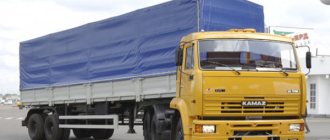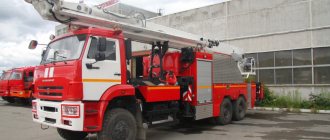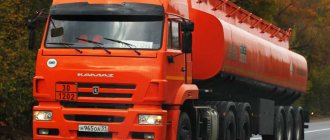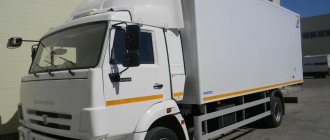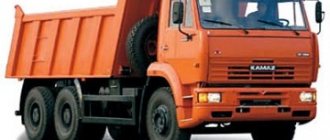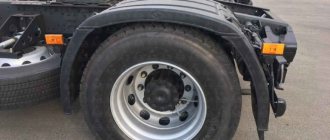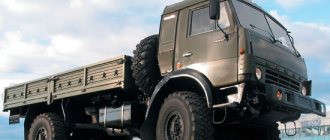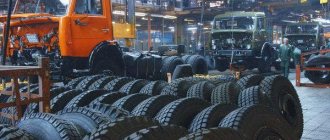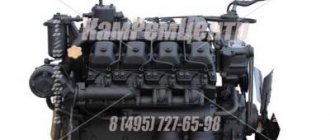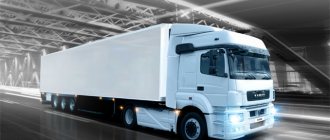The solution to certain problems of freight transport is determined by the developed power. The KamAZ turbocharger allows you to increase the operating capabilities of the vehicle, remaining one of the most effective ways, despite the efforts of scientists and designers in promoting potentially new ideas. Let's look at the characteristics and features of this device.
Purpose
The standard operation of a diesel engine involves the formation of a fuel-air mixture in the combustion compartment from the volume of air that enters “under its own power” when the piston is lowered. In this case, the fuel does not burn completely, potential energy is lost, and the power unit does not develop the power it is capable of. The KamAZ turbocharger allows you to forcibly increase the amount of air entering the combustion chamber. This is the simplest, but also the most effective solution to the problem.
The unit in question is supercharged. As a result, the fuel-air composition burns better as a result of oxygen saturation. If we look in more detail at how “better” the process is, you need to understand that a unit amount of fuel releases more energy, which increases engine power. As practice shows, the KamAZ-5490 turbocharger gives an increase in power of up to 40%. It is noteworthy that increasing the power rating does not require design changes to the engine.
Tuning KamAZ-740 engines
Install a turbine
You can install turbines on a regular naturally aspirated 740 by converting it into a 7403. To do this, you need to buy two TKR 7N1K turbines, replace the pistons with 7403 ones, install a pump and injectors from 7403, as well as an intake and exhaust system. Everything is ready, just put it together. You can install turbines on a completely standard engine and configure everything. This will work, perhaps even for a long time, but it is safer to convert to 7403.
One of the ways to increase the power of a diesel engine is a gas turbine supercharging system. Its main element is the turbocharger. It is installed on the discharge manifold and is driven by the energy of the exhaust gases. The use of a turbine on KamAZ gives an increase in engine power of about 25%. These trucks use two-row V-shaped power units. Therefore, 2 compressors are installed - each on its own unit.
Peculiarities
More active and dense combustion of fuel significantly reduces the emission of toxic exhaust gases. The amount of smoke is also reduced due to the reduction of residual solids (soot). Simply put, the overall environmental safety of the motor increases.
Installing a turbocharger on KamAZ increases fuel consumption. But, in general, fuel costs to obtain a unit of power in such an engine are lower than in a conventional analogue. That is, the supercharged engine is more voracious, but also more powerful. As a result, using a power unit with a turbine to obtain a specific power is more profitable than achieving the same indicator with a conventional diesel engine. Below is a diagram of a gas turbine supercharging system.
1 – heat exchanger; 2 – radiator of the cooling system; 3 – fan; 4 – motor; 5 and 6 – turbochargers.
How to install
Some owners of trucks with non-turbocharged engines independently install units to increase engine power. Installing a turbine on a simple KamAZ truck involves making a foundation, because The design does not provide for such a place. Most often, one unit is installed on both blocks. In most cases, turbochargers of Czech or German production are used.
Experts believe that before installing a turbocharger on a KamAZ-740 (simple), it is necessary to change the crankshaft and piston group to reinforced ones. Otherwise, problems will arise with the engine, and then more parts will have to be replaced.
Such units are also installed on turbocharged engines: one instead of two. This is cheaper, and the likelihood of failure is halved. This installation can be carried out either independently or by contacting a service. A specialized enterprise will not only carry out the work professionally, but will also provide a guarantee for its completion. Many car owners believe that it is much easier to install an engine of suitable power than to adapt a turbine to it, and carry out the settings by trial and error.
Before installation, you need to remove the transport plugs and fill in 20-30 grams of engine oil. After this, you need to check how the rotor rotates.
You can install the turbocharger yourself:
- Install the “snails” directly onto the engine (the installation diagram for each model is individual, described in detail in the operating manual)
- After the turbocharger is installed on the engine, it is necessary to connect it to various systems
- Connect the exhaust manifold: it is important that small parts and debris do not get into it, otherwise the rotor may jam
- Connect the exhaust pipe
- Install air duct
- Provide oil supply
During installation, you will need various sealing materials (seals), fittings, bolts, nuts, washers, clamps, tubes (may be included in the kit). On the websites of spare parts stores you can find catalogs that describe all the parts needed to install a specific turbocharger model.
A welding machine is required to connect the exhaust manifold.
Device
KamAZ turbochargers have a simple design. Essentially, two elements interact in this device (a centrifugal compressor and a gas turbine). The first component part consists of the following parts
- snail-shaped frame;
- wheels with working blades of a specific configuration;
- holes through which air enters, supplied through a diffuser into the intake manifold of the engine.
A gas turbine has a similar structure, only instead of air, exhaust gases are supplied to it, which are discharged into the exhaust system.
The wheels of both elements are connected by a central housing, and the torque is transmitted by a roller. Consequently, the energy for the operation of the unit is produced from exhaust gases.
1 – bearing; 2 – screen part; 3 – body; 4 – diffuser; 5 – seal ring; 6 – nut; 7 – oil reflector; 8 – compressor wheel; 9 – oil drain screen; 10 – damper; 11 – bearing frame; 12 – fasteners; 13 – adapter; 14 – gasket; 15 – turbine screen; 16 – wheel; 17 – body; 18 – seal.
What else is included in the turbocharging system?
The turbine is a complex unit; it took engineers several decades to perfect the system. Only at first glance, the solution to compensate for efficiency losses using exhaust gases seems simple. Even after the creation of the device, it had certain problems for a long time.
For example, it was not possible to solve the problem of turbo lag - a delay after pressing the gas pedal and starting the rotor. The solution was found in the form of using two valves. One of them was used to remove excess air, and the second was intended for exhaust gases. In addition, modern turbines have a modified blade geometry, which seriously distinguishes them from similar devices of the second half of the 20th century.
One more problem can be identified, which was excessive detonation - modern engineers have also successfully dealt with this. The problem was that the temperature in the working sectors of the cylinders increased sharply during air injection, especially in the last stage of the stroke. The solution was found in installing an intercooler (air intercooler).
Intercooler is a device for cooling charge air. It performs two functions at once - it prevents detonation and prevents air density from decreasing. As a result, it was possible to maintain the functionality of the entire system.
It is also worth noting other important components of the turbine.
Control valve. Responsible for maintaining a given pressure level; excess pressure enters the exhaust pipe.
Bypass valve. It is used to remove excess air masses back into the intake pipes - this is necessary to reduce power when there is excess power.
Bleeding valve. If the throttle closes and there is no MAF sensor, the valve will return excess air back to the atmosphere.
Pipes. Sealed pipe sections. Some are used to supply air, the other to supply lubricating oil.
Exhaust manifolds. Must be compatible with turbocharger.
Principle of operation
In the KamAZ turbocharger (Euro-1/2/3/4), exhaust gases are supplied to the turbine, interact with the wheel blades, transferring to it its own kinetic potential, spinning it up to 75 thousand rotations per minute. The turbine element transforms the torque into a compressor analogue, which takes in atmospheric air, actively throwing it towards the walls and accelerating it to high speed. Next, the mass enters the tapering diffuser part, where it is compressed, being fed under pressure into the intake manifold, then into the combustion compartments.
Since the turbine operates stably under high pressure and mechanical stress, its casing is made of special reinforced alloys. To ensure high rotation speed of the wheels, good lubrication of the bearings is required. This condition is ensured using oil lines that are connected to the engine lubrication system.
It is worth clarifying that KamAZ trucks are equipped with two-row V-shaped engines. For them, it is appropriate to use a pair of turbine compressors (one element for each row). It is more economical to use two small models than one large unit. The turbines of the devices in question have relatively small dimensions:
- impeller diameters - no more than 61 mm;
- similar dimensions of the turbine and compressor - 220 mm;
- The mass of one assembled element is about 7 kg.
The use of such compact units makes it possible to dramatically increase the motor parameter.
How to check
A turbocharger malfunction is characterized by the presence of one or more distinctive features:
- increased oil consumption;
- uncharacteristic sound of the operating unit;
- drop in power plant power;
- the appearance of gray or blue smoke from the exhaust pipe.
You can check the turbine without removing it from its original location. Primary diagnostics of the unit’s performance includes:
- inspection of turbine and compressor blades;
- checking the condition of the pipes;
- monitoring the presence of axial and radial play.
To check the condition of the blades, it is necessary to disconnect the exhaust pipe of the turbine and the pressure pipe of the compressor. The entry of even small solid particles into the working cavities leads to the formation of scuffs and chips on the body of the blades. At high rotation speeds (70-90 thousand rpm), this leads to imbalance of the turbine unit, uneven load on the bearings, vibration and, as a result, a drop in speed. Turbine malfunctions worsen boost parameters and reduce engine thrust.
The pipes must be free of oil. In some cases, oil fogging may be observed at the outlet of the compressor, but the pressure pipe remains dry. Oily pipes and increased oil consumption can be caused by both turbine and engine malfunctions. Correctly determining the location of the defect will allow you to make the right decision to eliminate it.
The presence of play in the radial and axial directions is fraught with the blades touching the walls of the cochlea. This can lead to complete destruction of the unit. Shift of the rotor in the axial direction is unacceptable. A play in the diametrical plane of no more than 1 mm is possible. If the rotor movement is greater than normal, then the turbine unit must be dismantled for repair or replacement.
If the diagnostic results failed to detect a malfunction, then it is necessary to check the tightness of the exhaust tract for the turbine and the pressure tract for the compressor. A drop in vehicle power may be due to poor adjustment or malfunction of the fuel equipment. The condition of the air filter has a great influence on the boost parameters.
Types and classes
There are four categories of engines that meet environmental standards on the modern market. Depending on these parameters, the type and brand of compressor is selected. The table below shows this information.
| Engine | Euro class | Compressor type |
| KamAZ 740.10 and 7403 | 0 | TKR7N-1 |
| KamAZ 740.11 and 740.13 | 1 | TKR7, K27, CZ, Schwitzer |
| KamAZ 740.31-240/740.51-320/740.30-260/740.50-360 | 2 | All of the above brands, modernized to Euro 2 |
| KamAZ 740.37-400/740.63-400/740.60-360/740.62-280/740.61-320 | 3 | Models K27-TI and Swiss Schwitzer S2B |
Some modifications of trucks are equipped with a KamAZ turbocharger (Euro 4). For now, it interacts only with the Cummins engine and differs in design and parameters from its domestic counterparts.
Manufacturers
The devices in question are produced by a limited number of manufacturers. Among them:
- KamAZ Joint Stock Company produces standard versions for its engines that are affordable. The range includes Euro 0-2 modifications.
- Association "Turbotechnika" (located in the Moscow region, Protvino). The company specializes in the production of TKR KamAZ turbochargers of various models.
- . Offers versions of K27-TI, standards from Euro 1 to Euro 3.
- The BZA company, located in Belarus, offers analogues to TKR7 type units.
- Czech plant in Strakonice. High-quality copies of the K-27 are made here, the price of which is slightly higher than domestic products.
- The German concern Borg Warner Turbo systems sells high-quality turbine compressors under the Schwitzer brand.
For KamAZ, all units are presented in right or left versions. This is important to consider when purchasing a product, since installation on the opposite row is impossible.
What turbines are installed on KamAZ
Today the most common is the KamAZ Euro-2 turbine. It is equipped with 4 brands of engines:
Compressors are produced by 3 Russian enterprises. The KamAZ association and OJSC Turbotekhnika produce TKR-7 turbine units. The characteristics of the product, made according to a two-console design, allow them to be used on Euro-1 engines. A Belarusian enterprise in the city of Borisov produces an analogue of the TKR-7 turbine. The German concern Borg Warner Turbo Systems produces high-quality products - with higher characteristics than Russian and Belarusian ones.
Vehicles equipped with Cummis power units are equipped with their own compressors. You need to know that in addition to these engines, the others are equipped with paired turbines: right and left. KamAZ Euro-3 trucks are most often equipped with units from the German brand Schwitzer.
Possible faults
Since the device in question experiences significant loads, it is not surprising that sooner or later it breaks. Among the common malfunctions:
- Insufficient oil supply. Dry-running bearings lead to shaft displacement, which can lead to deformation of the wheels and complete breakdown of the entire unit.
- Foreign objects entering the structure. In this case, a small piece or chip from a valve or piston will be enough for the rotor to jam. Most often, such a malfunction occurs due to violation of operating rules. Even getting in contact with a piece of fabric or rubber causes the blades of the element to bend.
- Deformation and wear of the KamAZ turbocharger gasket. In this case, the faulty element must be replaced.
Most often, the cause of failure is a lack of oil. This can happen even after the engine is stopped.
Repair recommendations
There are other reasons why turbine compressors fail. In most cases, the problem is solved radically - by purchasing a new model. Despite the fact that repairs will be cheaper, the restored unit will not work for long, which will require additional costs.
Repairing the device is complicated by the fact that the part is subjected to significant loads. Consequently, pinpoint precision is required when processing and installing spare parts. This requires special equipment and tools. Experts recommend purchasing a new unit because their price is affordable. Repairing only expensive analogues is partially justified.
Installation
Below are recommendations for installing a KamAZ turbocharger (Euro 2):
- You should first change the oil, air and oil filters.
- It is necessary to ensure that all plugs are removed from the unit.
- Thoroughly clean all supply and outlet lines.
- Install a new gasket.
- Follow the tightening torque recommended in the manufacturer's documentation.
- After starting the engine, check the mechanism for leaks, and before loading, let the engine idle for several minutes.
How much does the part cost?
The price of a turbocharger depends on the manufacturer and engine model. Domestic products for KamAZ Euro-2 can be purchased for 14-17 thousand rubles. Czech and German units cost about 20,000 rubles, and their analogues cost 15-16 thousand. The most expensive turbochargers on the market are products from the American company Cummins. The price for them starts from 20 thousand rubles, and some models will be sold for 35-37 thousand.
Remanufactured (used) turbines are much cheaper. They can be purchased at prices starting from 6,000 rubles.

